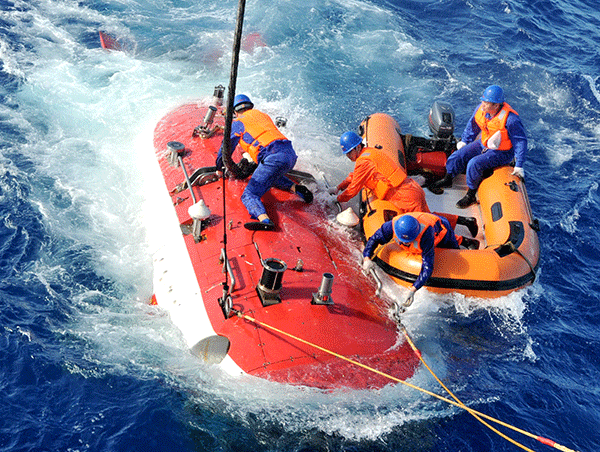 |
|
China's deep-sea manned submersible Jiaolong conducts scientific exploration in the southwestern Indian Ocean in December.[Photo/Xinhua] |
Country's role underlines the scale of its oceanic exploration and research
When most people hear the name Niao Chao, or "Bird's Nest", they immediately think of the National Stadium in Beijing, the site of the 2008 Olympic Games. However, there is another, less-famous Bird's Nest related to China: a 250-meter-high mound, nearly 3,000 meters below the surface of the eastern Pacific Ocean.
The hill, a small volcano, was discovered by the Chinese research vessel Dayang Yihao in August 2008. The name was suggested by its sunken summit, which resembles a sports arena, coupled with the then-ongoing Olympics.
Since 2010, when China first became involved in the naming of undersea features, 56 of the names it has submitted have been approved by the Sub-Committee on Undersea Feature Names, an influential body in the field and a branch of the General Bathymetric Chart of the Oceans, an international group of experts specializing in the development of submarine data.
The ability to name such features is a good indication of China's ability to explore the deepest water, and its willingness to serve the international community, according to the State Oceanic Administration.
On Oct 9, the SOA suggested 124 new Chinese names for seabed areas in the Atlantic, Pacific and Indian oceans. Thirteen of them were approved at the annual meeting of the sub-committee, which is currently underway in Niteroi, Brazil.
Li Bo, deputy director of the China Ocean Mineral Resources Research and Development Association-the official organization engaged in exploration and development of the ocean floor and subsoil-said the country's participation in the naming of undersea features has risen sharply in recent years.
He said new names have been suggested for features discovered or explored by Chinese oceanic research facilities, totaling 101 features in the Pacific Ocean, 15 in the Indian Ocean and eight in the Atlantic Ocean.
In the past two decades, the association has organized 36 cruises for oceanic and scientific research, according to Li, who said the ability to name features in distant oceans underscores the vast distances covered and the scale of seabed exploration undertaken by Chinese teams.
Looking to the future
"It was a little late for China to participate in the work in 2010, but since then development has been rapid," he said. "We will propose more names in the future."
Major Western countries have their own committees to name undersea features, and many participated in the work before 1973, the year the Sub-Committee on Undersea Feature Names was founded.
According the UN Convention on the Law of the Sea, naming rights usually belong to the feature's sovereign owner or discoverer, but countries may propose names even if the feature is partially or entirely outside their territorial waters.
Since 1973, the sub-committee has approved 3,862 names proposed by a number of countries, and China has proposed names at every annual meeting since 2010, according to Chen Yue, a senior official in international affairs at the State Oceanic Administration.
"Now, a growing number of developing countries, such as Brazil and Malaysia, are participating in the work," she said. "That means developing countries, including China, are increasing their capabilities to conduct deep-sea research. We are paying greater attention to oceanic research and development."
In 2011, China signed a contract with the International Seabed Authority to search for polymetallic sulphides in a 10,000-square-kilometer section in the southwestern Indian Ocean seabed. The agreement followed two exploration contracts for areas in the Pacific Ocean.
In March, the manned deep-sea submersible Jiaolong finished a 118-day exploratory voyage in the Indian Ocean, while the research ship Dayang Yihao was also on a mission in the area. It was the first time two major Chinese oceanic research facilities had worked in the Indian Ocean at the same time.
Honoring past heroes
In 2010, the China Ocean Mineral Resources Research and Development Association established a system for naming areas of the seabed based on ancient poetry and the names of famous Chinese, including navigators and poets from ancient times.
The Classics of Poetry, also known as the Book of Odes, is the oldest known collection of Chinese poetry and features works written in the period between the 11th and 7th centuries BC.
This year, China is proposing that a seamount in the South Atlantic should be named after Xunmei, "extremely wonderful", a quotation from a poem in the Book of Odes. A hill in the East Pacific may also be named after Su Shi, a famous poet and calligrapher of the Song Dynasty (960-1279).
"Once a name is decided, it will never change. Every time people use that name, they have a chance to learn about the culture and history behind it. It's a great opportunity to introduce Chinese culture and history to the world. Many countries name features after their own cultural relics and icons," said Lin Shaohua, a senior researcher and member of the naming committee at the SOA.
She said few features are named after living people, because the committee prefers to honor those who made remarkable contributions in their chosen fields throughout their lifetimes, and people with strong maritime connections are always at the top of the list.
